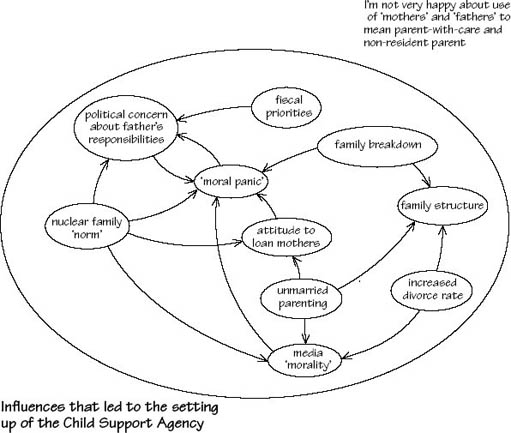9.4 Influence diagrams
I want to return to the definition of a system I used earlier: an assembly of components interconnected as if they had a purpose. In the last section, I used purpose as a way of structuring the complexity of the case study. In this section, and the sections that follow, I want to turn to the idea of interconnectedness as another way of structuring the complexity. In the case of influence diagrams, I search for interconnection in the form of influence to hold together a structure that resolves some of the complexity.
There are at least two ways of looking for influence connections from the myriad of possibilities a complex situation presents. The first is to start from a systems map, modifying it and adapting to identify the principal interconnections. The second is to start by identifying a component in the complexity that seems to be influential and building the influence diagram from there. There are advantages and disadvantages to both.
Allow yourself about 30 minutes to do the following activity. If this is your first attempt at an influence diagram, expect to take at least twice as long.
Activity 23
Draw an influence diagram that structures a system of influences within the case study.
Either use your systems map as a starting point or identify an alternative starting point within the complex situation.
Remember to give your diagram a title that matches the diagram. Use the guidelines given in T552_1 Systems diagramming.
As you do your diagram, make notes about any advantages or disadvantages you notice about your chosen approach. A good starting point for this is to notice why you are choosing your particular approach.
Make notes about any insights you gain about the situation as you draw your diagram.
When you think you have finished your diagram, check the guidelines rigorously. If you are uncertain you have complied with the rules, be strict with yourself about getting it right. Experience shows these points are the most effective at unlocking your understanding of the complexity.
Two of the hardest things to know when you are diagramming is whether you've got it right and when it's complete. These concerns come up in all diagramming but seem to me to be particularly tricky when it comes to influence diagrams.
The first concern is the issue of rightness. I use diagrams mostly for exploring complex situations. This usually happens when I'm baffled by something and cannot see a way of getting to grips with it. The bafflement I experience often arises from false assumptions I am making; mis-attributions of connection and so on. So, in endeavouring to understand the complex situation, I am dealing with misunderstandings as well as lack of understanding. Following the rules, tedious though that often seems is, for me, a powerful way of unearthing misunderstandings. The challenge of forcing the representation into technically correct, diagrammatic form meets the misunderstandings head-on. Since other people seem to experience this too, I am encouraging you, in the activities, not to let yourself get away with bending the rules until you're absolutely sure it's justified. Use the rules rigourously as a form of challenge to your understanding.
Concerning completeness, I often find once I am no longer baffled the rest is relatively easy to understand. So in diagramming, I am often looking for an understanding that makes me feel more prepared to explore. So, in some senses, completeness is when I feel I have enough understanding to start being more directed in my exploration. This may involve further, more detailed, diagrams. This intuitive sense that it's complete when I feel it's complete enough, works well enough for me when I'm working by myself. A more appropriate idea of completeness for diagrams to be used with other people might include additional features. In this, a guideline that works well for me is to ask if there is a good match between the diagram and its title, and to ask if the diagram shows all the relevant pieces to meet the aims implied by the title. But a diagram for showing to other people also has to show something. It must actually be capable of being read. This may involve pruning so that I don't simply reproduce the complexity in diagrammatic form.
Drawing an influence diagram about this situation illustrates the point about completeness. I discovered an important insight. I was trying to trace some of the influences that lead to the unpopularity and the perceived failure of the CSA. I had two diagrams that didn't fit. One of them seemed to be turning into a multiple-cause diagram, so I shelved that for later. The other seemed to concern the motivations that led to the setting up of the CSA.
I discovered there seemed to be little coherence between the motivations that led to its setting up and what it actually set about doing. The motivations seemed to be mostly driven by the moral panic about so-called runaway fathers and feckless mothers, and a desire to reduce the welfare bill for supporting single-parent families. What the CSA was actually doing was more concerned with re-working maintenance agreements and court orders.
This insight seemed important enough to preserve the diagram so I drew it in a form that would be presentable to you. It is shown as Figure 15. I feel it is complete because it seems to represent all the reported motivations the government had in setting up the CSA. Again, you should not interpret my diagram as a model answer.
I decided to stick with the wording used in the case study, although I wondered if it was a trap in itself. The close identification of the parent-with-care with the mother, and the identification of absent parent with the father, might be a trap in my thinking and possibly in the thinking of the people in the situation.

